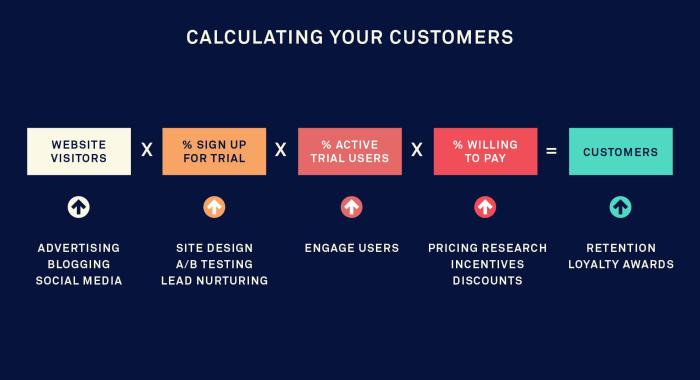Increasing User Engagement kicks off our journey into the realm of digital success, where captivating users is key. Get ready to dive into tactics, metrics, and social media strategies that drive engagement sky-high.
Importance of User Engagement
User engagement is crucial for the success of digital platforms as it directly impacts the overall performance and growth of businesses. When users are actively engaged with a platform, they are more likely to spend time on it, interact with content, make purchases, and ultimately contribute to the platform’s success.
High User Engagement Benefits
- Increased Conversion Rates: Platforms with high user engagement often see higher conversion rates as engaged users are more likely to make purchases or sign up for services.
- Brand Loyalty: Engaged users tend to develop a sense of loyalty towards a platform, leading to repeat visits and continued usage.
- Word-of-Mouth Marketing: Users who are engaged are more likely to share their positive experiences with others, leading to organic growth through word-of-mouth marketing.
- Feedback and Improvement: Engaged users provide valuable feedback that can help businesses improve their products or services, leading to overall growth and success.
User Engagement and Customer Loyalty
User engagement plays a crucial role in building customer loyalty. When users are engaged with a platform, they are more likely to develop a strong connection with the brand, leading to repeat business and long-term customer relationships. By fostering a sense of community and actively involving users in the platform’s development, businesses can create a loyal customer base that continues to support and advocate for the brand.
Strategies to Increase User Engagement
To enhance user engagement, various tactics can be implemented to create a more interactive and personalized experience for users. These strategies can help drive user interaction and improve overall engagement with the platform or website.
Gamification
Gamification involves incorporating game-like elements such as challenges, rewards, and leaderboards into the user experience. By adding elements of competition and achievement, users are motivated to engage more with the platform. This can increase user retention and loyalty as users strive to earn rewards and reach new levels.
- Implementing badges or achievements for completing certain tasks or milestones
- Creating interactive quizzes or games to make the user experience more enjoyable
- Rewarding users with points or discounts for engaging with the platform
Personalized Content
Personalizing content based on user preferences and behavior can significantly impact user engagement. By delivering tailored recommendations, product suggestions, or content that aligns with the user’s interests, users are more likely to interact with the platform and spend more time exploring the content.
- Utilizing user data to recommend relevant products or articles
- Creating personalized email campaigns with targeted content
- Offering customization options for users to personalize their experience
Interactive Features
Integrating interactive features such as live chats, polls, surveys, or interactive videos can enhance user interaction and engagement. These features allow users to actively participate and provide feedback, making the user experience more dynamic and engaging.
- Adding a live chat support for real-time assistance
- Running polls or surveys to gather user feedback and opinions
- Creating interactive videos with clickable elements for user engagement
Measuring User Engagement: Increasing User Engagement

User engagement is a crucial aspect of any online platform, and measuring it accurately is essential to understand how users interact with the content. Here, we will delve into key metrics and strategies for evaluating and optimizing user engagement.
Key Metrics for User Engagement
- Bounce Rate: This metric measures the percentage of visitors who navigate away from the site after viewing only one page. A high bounce rate could indicate that the content is not engaging enough or that the website is not user-friendly.
- Time on Page: The average time users spend on a particular page. Longer time on page generally indicates higher engagement and interest in the content.
- Click-Through Rate (CTR): CTR measures the percentage of users who click on a specific link, advertisement, or call-to-action. A high CTR signifies that users are actively engaging with the content.
Importance of A/B Testing
A/B testing is a valuable technique used to compare two versions of a webpage or app to determine which one performs better in terms of user engagement. By testing different elements, such as headlines, images, or call-to-action buttons, businesses can optimize their strategies to enhance user engagement effectively.
Tools for Measuring User Engagement
- Google Analytics: A popular tool that provides detailed insights into user behavior, including bounce rate, time on page, and conversion tracking.
- Hotjar: Offers heatmaps, session recordings, and surveys to understand how users interact with the website and identify areas for improvement.
- Crazy Egg: Provides heatmaps, scroll maps, and A/B testing tools to optimize website design and increase user engagement.
Enhancing User Engagement through Social Media

In today’s digital age, social media has become a powerful tool for enhancing user engagement. By utilizing various social media platforms effectively, businesses can connect with their audience on a more personal level and encourage interaction. Let’s explore how social media can be leveraged to boost user engagement.
Creating Shareable Content, Increasing User Engagement
Creating shareable content is key to increasing user interaction on social media platforms. Here are some tips to help you create content that users will want to share:
- Focus on visuals: Images and videos tend to perform well on social media and are more likely to be shared by users.
- Inject personality: Showcasing the human side of your brand can help foster a connection with your audience and encourage sharing.
- Ask questions: Encouraging users to engage by asking questions can spark conversations and boost interaction.
- Offer value: Providing valuable and informative content will make users more likely to share your posts with their followers.
User-Generated Content
User-generated content plays a significant role in fostering engagement on social media. When users create and share content related to your brand, it not only increases visibility but also builds trust and credibility. Here’s how user-generated content can enhance user engagement:
- Authenticity: User-generated content is perceived as more authentic and trustworthy by other users, leading to increased engagement.
- Community building: Encouraging users to share their experiences with your brand can help create a sense of community and loyalty among your audience.
- Increased reach: When users share their content featuring your brand, it can help reach a wider audience and attract new followers.